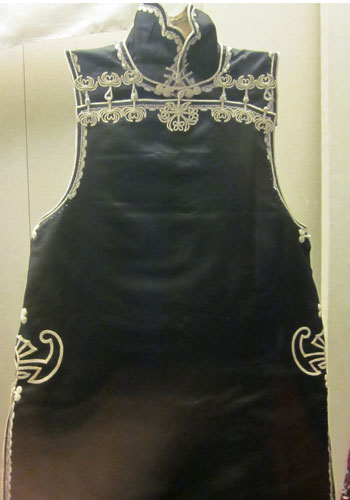Hidden Treasure: Museum of Ethnic Costumes preserves Cultural Heritage
|
|
|
A Han qipao (dress) at the Museum of Ethnic Costumes. [Photo:CRIENGLISH.com] |
A large portion of the museum's ethnic clothing belongs to the Miao minority group which has more than 100 different kinds of costumes. The Miao costumes represent a visual history of the group, documenting their migration patterns. Liu pointed out that the square patterns on one Hua Miao dress represented the city walls, while curved patterns represented Dongting Lake.
Many of the Miao designs also incorporate butterflies which the group considers to be a mother figure. Their ethnic costumes are also characterized by striking colors.
Connecting the Miao designs with other ethnic groups in China are the silver ornaments commonly found on ethnic minority costumes. They represent wealth, and many groups believe that they drive away evil.
Other costumes in the museum directly contradict Han taboos, such as some Tibetan robes adorned with brocaded dragons. In Han culture, only members of the royal family can wear dragons. Additionally, dragons represent masculinity, but can be found on some robes of Tibetan women, denoting their high status.
One of the most unusual finds in the museum is made entirely of salmon skin. The costume belongs to the Hezhe minority group which relies on fishing for their livelihood.
"They made this kind of costume years ago when they didn't have enough cloth," Liu said.
While the museum's costumes represent China's diverse ethnic groups, the clothing itself has changed over time. The Han exhibition room follows the development of Chinese fashion from the Qin Dynasty to the present, noting the evolution of Han dress throughout history. One example of this evolution is the large, curved sleeves of Qing Dynasty robes which indicate a blend of Manchu and Han ethnic cultures.
Modern incarnations of traditional Chinese symbols can be found in a small room dedicated to the uniforms of the 2008 Summer Olympic Games. The institute had designed the cloud patterns for the uniforms' logo.
"The patterns on the costumes for the torch relay stem from the patterns on a costume from the Ming Dynasty," Liu said. "They are a combination of the phoenix and cloud. When the phoenix meets fire, it means hope."
To help students draw inspiration from traditional Chinese dress, several classes are held in the museum, but the collections are also open to the public during certain hours.
Opened in 2000, the museum is the first costume museum in China, and one of the first to offer free admission to the public.
Location: A2, Yinghua Road, northern entrance of Heping Street, Chaoyang District
Transportation: Bus No. 13, 62, 117, 119, 361, 379, 416, 419, 422, 606, 713, 725, 730, 807, 847, special 8 and Yuntong 101 to northern entrance of Heping Street, east Yinghua Street or China-Japan Hospital or take subway line 5 to Heping Xi Qiao and get a taxi (about 10 yuan).
Opening Hours: Monday and Tuesday 8:30 a.m.-11:30 a.m.; Thursday, Friday and Saturday 1:30 p.m.-4 p.m.
Admission: Free
Telephone: (+86) 10-6428 8261
 0
0 








